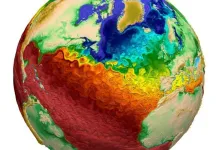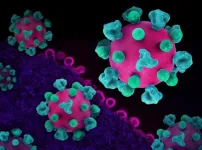(Press-News.org) On the beach, ocean waves provide soothing white noise. But in scientific laboratories, they play a key role in weather forecasting and climate research. Along with the atmosphere, the ocean is typically one of the largest and most computationally demanding components of Earth system models like the Department of Energy’s Energy Exascale Earth System Model, or E3SM.
Most modern ocean models focus on two categories of waves: a barotropic system, which has a fast wave propagation speed, and a baroclinic system, which has a slow wave propagation speed. To help address the challenge of simulating these two modes simultaneously, a team from DOE’s Oak Ridge, Los Alamos and Sandia National Laboratories has developed a new solver algorithm that reduces the total run time of the Model for Prediction Across Scales-Ocean, or MPAS-Ocean, E3SM’s ocean circulation model, by 45%.
The researchers tested their software on the Summit supercomputer at ORNL’s Oak Ridge Leadership Computing Facility, a DOE Office of Science user facility, and the Compy supercomputer at Pacific Northwest National Laboratory. They ran their primary simulations on the Cori and Perlmutter supercomputers at Lawrence Berkeley National Laboratory’s National Energy Research Scientific Computing Center, and their results were published in the International Journal of High Performance Computing Applications.
Because Trilinos, a database of open-source software ideal for solving scientific problems on supercomputers, is written in the C++ programming language and Earth system models like E3SM are typically written in Fortran, the team took advantage of ForTrilinos, a related software library that incorporates Fortran interfaces into existing C++ packages, to design and customize the new solver, which focuses on barotropic waves.
“A useful feature of this interface is that we can use every component of the C++ package in the Fortran language so we don’t need to translate anything, which is very convenient,” said lead author Hyun Kang, a computational Earth system scientist at ORNL.
This work builds on research results published in a previous Journal of Advances in Modeling Earth Systems paper in which researchers from ORNL and Los Alamos National Laboratory produced a code by hand to improve MPAS-Ocean. Now, the ForTrilinos-enabled solver has overcome the remaining drawbacks of the solver from the previous study, especially when users run MPAS-Ocean using a small number of compute cores for a given problem size.
MPAS-Ocean’s default solver relies on explicit subcyling, a technique that uses many small time intervals, or time steps, to calculate the characteristics of barotropic waves in conjunction with baroclinic calculations without destabilizing the model. If a baroclinic wave and a barotropic wave can be advanced with time step sizes of 300 seconds and 15 seconds, respectively, the barotropic calculation will need to complete 20 times more iterations to maintain the same speed, which takes a massive amount of computing power.
In contrast, the new solver for the barotropic system is semi-implicit, meaning it is unconditionally stable and thus allows researchers to use the same number of large time steps without sacrificing accuracy, saving significant amounts of time and computing power.
A community of software developers has spent years optimizing various climate applications in Trilinos and Fortrilinos, so the latest MPAS-Ocean solver that leverages this resource outperforms the hand-crafted solver, allowing other scientists to accelerate their climate research efforts.
“If we had to individually code every algorithm, it would require so much more effort and expertise,” Kang said. “But with this software, we can run simulations right away at faster speeds by incorporating optimized algorithms into our program.”
Although the current solver still has scalability limitations on high-performance computing systems, it performs exceptionally well up to a certain number of processors. This disadvantage exists because the semi-implicit method requires all processors to communicate with one another at least 10 times per time step, which can slow down the model’s performance. To overcome this obstacle, the researchers are currently optimizing processor communications and porting the solver to GPUs.
Additionally, the team has updated the time stepping method for the baroclinic system to further improve MPAS-Ocean’s efficiency. Through these advances, the researchers aim to make climate predictions faster, more reliable and more accurate, which are essential upgrades for ensuring climate security and enabling timely decision-making and high-resolution projections.
“This barotropic mode solver enables faster computation and more stable integration of models, especially MPAS-Ocean,” Kang said. “Extensive use of computational resources requires an enormous amount of electricity and energy, but by speeding up this model we can reduce that energy use, improve simulations and more easily predict the effects of climate change decades or even thousands of years into the future.”
This research was supported by E3SM and the Exascale Computing Project, or ECP. E3SM is sponsored by the Biological and Environmental Research program in DOE’s Office of Science, and ECP is managed by DOE and the National Nuclear Security Administration. The Advanced Scientific Computing Research program in DOE’s Office of Science funds OLCF and NERSC.
UT-Battelle manages ORNL for DOE’s Office of Science, the single largest supporter of basic research in the physical sciences in the United States. The Office of Science is working to address some of the most pressing challenges of our time. For more information, please visit https://energy.gov/science. — Elizabeth Rosenthal
END
Custom software speeds up, stabilizes high-profile ocean model
2023-12-14
ELSE PRESS RELEASES FROM THIS DATE:
Can you change a chicken into a frog, a fish or a chameleon?
2023-12-14
Gastrulation is one of the most important phases in early embryonic development. Before gastrulation, vertebrate embryos are simple two-dimensional sheets of cells. By the end of gastrulation, an embryo will have begun to differentiate distinct cell types, set up the basic axes of the body and internalize some of the precursors for organs in a three-dimensional structure. Amniotes, like chickens and humans, will have developed a primitive streak, the precursor to the brain and skin, while fish and amphibians will have developed a spherical-shaped ...
How the immune system fights to keep herpes at bay
2023-12-14
Herpes simplex virus (HSV) is extremely common, affecting nearly two-thirds of the world’s population, according to the World Health Organization.
Once inside the body, HSV establishes a latent infection that periodically awakens, causing painful blisters on the skin, typically around the nose and mouth. While a mere nuisance for most people, HSV can also lead to dangerous eye infections and brain inflammation in some people and cause life-threatening infections in newborns.
Researchers have long known ...
Drones capture new clues about how water shapes mountain ranges over time
2023-12-14
UNIVERSITY PARK, Pa. — Drones flying along miles of rivers in the steep, mountainous terrain of central Taiwan and mapping the rock properties have revealed new clues about how water helps shape mountains over geological time, according to a team led by Penn State scientists.
The researchers found a link between the size of boulders in the rivers and the steepness of the rivers. The link shows how rock properties can influence the relationship between tectonic processes happening deep underground and how mountainous landscapes ...
NIH research identifies opportunities to improve future HIV vaccine candidates
2023-12-14
WHAT:
An effective HIV vaccine may need to prompt strong responses from immune cells called CD8+ T cells to protect people from acquiring HIV, according to a new study from researchers at the National Institute of Allergy and Infectious Diseases (NIAID), part of the National Institutes of Health, and colleagues. The study findings, appearing in Science, draw comparisons between the immune system activity of past HIV vaccine study participants and people with HIV who naturally keep the virus from replicating even in the absence of antiretroviral ...
Can an app improve your romantic relationship?
2023-12-14
Half of all marriages in the United States are likely to fail by the time the spouses reach their 50s. Understandably, many couples are looking for ways to avoid becoming part of that statistic, well aware of a divorce’s possible wide-reaching detrimental effects on families, children, personal finances, individual well-being—and direct and indirect costs to society.
Ronald Rogge, an associate professor of psychology at the University of Rochester, has been researching the complex dynamics ...
Climate-smart ocean planning in Antarctica awarded with 1.5M€ ERC starting grant
2023-12-14
Catarina Frazão Santos, researcher at the Faculty of Sciences of the University of Lisbon (Portugal) (Ciências ULisboa), has been awarded by the European Research Council (ERC) with a Starting Grant of approximately 1.5 million euros to study the benefits and challenges of developing sustainable, equitable and climate-smart marine spatial planning processes in Antarctica and beyond.
“We need to raise awareness and foster a ‘paradigm shift’ on how to plan for sustainability and equity in a changing ocean,” says Catarina ...
Researchers, Coast Salish people analyze 160-year-old indigenous dog pelt in the Smithsonian’s collection
2023-12-14
Researchers from the Smithsonian’s National Museum of Natural History led a new analysis that sheds light on the ancestry and genetics of woolly dogs, a now extinct breed of dog that was a fixture of Indigenous Coast Salish communities in the Pacific Northwest for millennia. Anthropologist Logan Kistler and evolutionary molecular biologist Audrey Lin analyzed genetic clues preserved in the pelt of “Mutton,” the only known woolly dog fleece in the world, to pinpoint the genes responsible for their ...
Diverse gut bacteria communities protect against harmful pathogens by nutrient blocking
2023-12-14
UNDER EMBARGO UNTIL 19:00 GMT / 14:00 ET THURSDAY 14 DECEMBER 2023
Diverse gut bacteria communities protect against harmful pathogens by nutrient blocking
New study demonstrates that diverse communities of resident bacteria can protect the human gut from disease-causing microorganisms.
However, this protective effect is lost when only single species of gut bacteria are present.
The researchers found that protective communities block the growth of harmful pathogens by consuming nutrients that the pathogen needs.
The findings, published today in the journal Science, could help to develop new strategies to optimise gut health.
The ...
Astronomers discover first population of binary stripped stars
2023-12-14
Astronomers at the University of Toronto have discovered a population of massive stars that have been stripped of their hydrogen envelopes by their companions in binary systems. The findings, published today in Science, shed light on the hot helium stars that are believed to be the origins of hydrogen-poor core-collapse supernovae and neutron star mergers.
For over a decade, scientists have theorized that approximately one in three massive stars are stripped of their hydrogen envelope in binary systems. Yet, until now, only one possible candidate had been identified.
“This was such a big, glaring hole,” says co-lead author ...
Ancient genomics and Indigenous Knowledge reveal history of Coast Salish “woolly dogs”
2023-12-14
DNA analysis of a 19th-century dog, paired with traditional knowledge acquired through interviews, have together provided new insights into the decline of Coast Salish “woolly dogs” – an extinct Indigenous dog once bred for its unique woolly coat. Dogs were introduced to the Americas at least 15,000 years ago and have been ubiquitous in Indigenous societies across the continents for thousands of years. Coast Salish peoples – a group of Indigenous societies that lived in the Salish Sea region of the Pacific Northwest (PNW) – kept several different types of dogs, including a special lineage of “woolly ...






